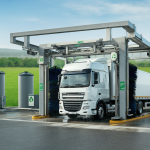The transportation industry is the backbone of commerce worldwide, and with every mile logged on the road, vehicles get dirty. Commercial fleet washing businesses have historically filled this indispensable niche, providing critical maintenance to keep fleets running efficiently and professionally. But as we approach 2025, is this industry still a lucrative opportunity for investors and entrepreneurs? This blog explores the market’s current landscape, emerging trends, profitability factors, and potential risks to help you decide if this is the right venture to pursue.
Understanding the Current Market Landscape
The commercial fleet washing industry has grown steadily over the years, supported by the expanding logistics and transportation sectors. According to IBISWorld, the fleet washing industry in the U.S. generates over $12 billion annually, with a moderate annual growth rate of approximately 2.5%. The market’s stability stems from the consistent demand for services from enterprises requiring clean, well-maintained vehicles, from delivery vans and buses to large freight trucks.
Key players in the market include established companies such as Blue Beacon Truck Wash and ZIPS Car Wash, as well as emerging regional operators. Competition is relatively fragmented, offering opportunities for new entrepreneurs to carve out niches with specialized or innovative offerings.
Market Drivers
Several factors are propelling the demand for fleet washing services:
- Rising Environmental Standards: Many fleet operators now require compliance with eco-friendly standards for washing facilities, generating demand for solutions that meet EPA guidelines.
- Industry Growth: With the boom in e-commerce and last-mile deliveries, the number of commercial fleets needing washing services continues to increase.
- Brand Image and Maintenance: For many businesses, clean fleets are essential for maintaining positive brand impressions and limiting long-term wear and tear.
Trends and Technologies Shaping the Future
To address evolving customer needs, the commercial fleet washing industry is undergoing a wave of innovation. Here are three game-changing trends:
1. Eco-Friendly Washing Solutions
The focus on sustainability is reshaping how commercial fleet washing businesses operate. Solutions like water reclamation systems, biodegradable detergents, and low-water-usage equipment are becoming industry standards. Businesses delivering eco-friendly or EPA-compliant options are not only appealing to environmentally-conscious clients but are also positioning themselves for long-term growth amid tightening regulatory guidelines.
2. Automation and Touchless Fleet Washing
Automation and touchless washing technologies are on the rise to meet fleet owners’ demand for efficiency and reduced liability for vehicle damage. For instance, brushless fleet washing systems eliminate mechanical contact with vehicle surfaces, offering faster, safer, and cleaner services. Startups in this space are leveraging these advancements to differentiate themselves in crowded markets.
3. Digital Marketing and Online Booking
Digital platforms are revolutionizing customer acquisition and retention in the service industry. From online booking systems and subscription models to targeted location-based ads, technology gives fleet washing businesses an edge in marketing and client retention.
Investment Considerations
Thinking about starting or investing in a commercial fleet washing business? Here’s what you need to consider:
Startup Costs
Launching a fleet washing business requires a significant upfront investment. Depending on the location, fleet size, equipment (e.g., touchless or brush systems), and real estate costs, you may need between $50,000 and $300,000 to start. Mobile fleet washing services offer a lower-cost entry point, as they typically eliminate some infrastructure-related expenses.
Operational Expenses
Recurring costs include water, detergents, eco-friendly systems, employee wages, equipment maintenance, and insurance. Staying competitive involves continuously upgrading equipment to meet new standards and customer expectations.
Revenue Potential
The revenue potential for a fleet washing business is substantial, especially when targeting large clients like logistics companies or municipalities. Monthly service contracts can provide consistent income, with average contracts ranging from $500 to $3,000 per fleet. Additional services, such as detailing and undercarriage cleaning, can further boost profits.
Profit Margins
Profitability margins can range from 20% to 35%, depending on how efficiently you manage costs and the value-added services you offer. Franchise models with well-established names like Blue Beacon report even higher profit margins due to brand recognition.
Risks and Challenges in the Industry
While the industry offers excellent business opportunities, it’s not without risks. Here are the challenges to be mindful of:
- Regulatory Compliance: Stricter environmental compliance measures can be both a challenge and a financial burden. It’s essential to stay ahead of evolving EPA regulations.
- Competition: While fragmented, the competitive landscape still demands differentiation through technology, pricing, or service quality.
- Economic Cycles: Economic downturns may lead businesses to cut non-essential expenses, potentially affecting fleet washing demand.
- Labor Costs: Retaining skilled employees for mobile or full-service locations can be challenging in a competitive labor market.
Case Studies: Successful Fleet Washing Businesses
Blue Beacon Success Story
Blue Beacon Truck Wash has achieved immense success by leveraging automation and sustainability, operating over 100 locations across the U.S. Their focus on fast, efficient, and eco-friendly washes has made them a favorite among professional truck drivers and fleet managers.
Startup Spotlight – Eco Fleet Wash
Eco Fleet Wash is a mobile fleet washing startup based out of Austin, Texas. By offering waterless washing solutions and 24/7 on-site service, it has attracted contracts with local delivery fleets and courier services. Their use of digital marketing has helped them grow from a one-person operation to a five-truck fleet in just two years.
2025 and Beyond: What’s Next for Fleet Washing?
Looking forward, the industry is poised for steady growth, driven by rising global commerce and technological innovations. By 2025, touchless and brushless fleet washing solutions will likely dominate the market due to their focus on efficiency and damage prevention, while mobile operations will continue gaining traction as companies seek cost-effective and flexible solutions.
Emerging startups focused on sustainability will stand out, as environmental standards become non-negotiable. Integration of IoT (Internet of Things) in washing systems can also unlock new revenue opportunities by providing real-time data and predictive maintenance capabilities.
Insights from Experts
We spoke to industry experts and analysts for their perspectives:
- John Kingston, Industry Analyst at FleetInsight Research, says, “Fleet washing services remain a critical part of operational maintenance for transportation companies. With the inclusion of eco-friendly practices, they can tap premium pricing models.”
- Linda Sharp, Operations Consultant at Franchise Business Review, recommends, “Target a niche market, like electric vehicle fleets or municipal vehicles, to secure repeat customers who demand specialized services.”
Is It Worth the Investment?
After analyzing the market, trends, and potential pitfalls, it’s clear that commercial fleet washing businesses can still be a profitable investment in 2025 for those willing to adapt to changing industry dynamics. Focus on sustainability, technology, and innovative operational models to set yourself apart.
For aspiring entrepreneurs, a mobile operation offering eco-friendly solutions is a cost-effective way to enter the market. Established investors may prefer leveraging franchising opportunities, benefiting from established brand equity and infrastructure.
Final Recommendation: Do your homework, choose your niche carefully, and adopt cutting-edge technologies. With the right approach, this industry offers excellent business opportunities for growth and profitability.




